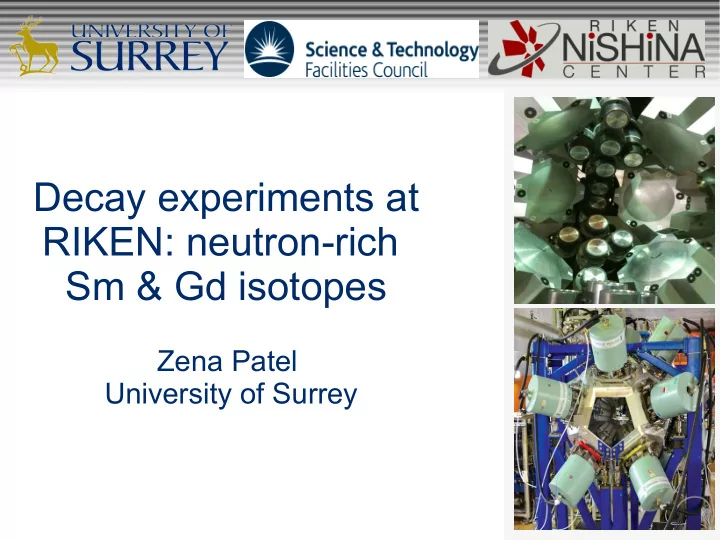

Decay experiments at RIKEN: neutron-rich Sm & Gd isotopes Zena Patel University of Surrey
Radioactive Isotope Beam Factory: RIBF Linac + 4 cyclotrons: RRC, fRC, IRC, SRC → 70% c Be target with various beams U: 345 MeV/nucleon U: 10-15 pnA
BigRIPS & ZeroDegrees
BigRIPS detectors PPAC: Parallel Plate Avalanche Counter → trajectory of particle TEGIC: Tilted Electrode Gas Ionisation Chamber → energy loss of particle Plastic detectors → TOF of particle
WAS3ABI & EURICA WAS3ABI: Wide-range Active Silicon-Strip Stopper Array for Beta and Ion detection Upto 5 DSSDs 60x40 1mm strips EURICA: Euroball RIKEN Cluster Array 84 HPGe crystals in 12x7 clusters from the RISING array Analogue & digital branches for energy & timing LaBr 3 (Ce) (Surrey & Brighton) and plastics
The nuclear landscape Analysis in other regions is ongoing
Published results: 131In 131In = 1 proton hole nucleus w.r.t. 132Sn New single-particle state (red) in 131In used for shell model calculations below N=82 No evidence for a Z=40 subshell closure at N=82 J. Taprogge et. al. Phys. Rev. Lett. 112, 132501 (2014)
Published results: 126,128Pd New isomers in 126Pd & 128Pd Lowest Z for N=82 Evidence for a robust N=82 shell closure 126 Pd 80 128 Pd 82 H. Watanabe et. al. Phys. Rev. Lett. 111, 152501 (2013)
Published results: β decay around 78Ni Half-life (ms) 5 new β t 1/2 s measured Half-lives show magicity of Neutron Number Z=28 & N=50 Z. Y. Xu et. al. Phys. Rev. Lett. 113, 032505 (2014)
Fast timing data: 104Zr Previously measured as: τ (2+) = 2.9(4) ns F. Browne, University of Brighton
Mid-shell region Maximum deformation expected at doubly mid-shell region Closed-shell nuclei → “waiting points” of the r process REP → mid-shell nuclear deformation
K isomers Nuclear deformation → K isomers Quasiparticle configuration → spin projections, K, on symmetry axis Transitions can be forbidden by ΔK≤λ K-forbiddenness → long-lived states: K isomers Use to probe low-lying excited states
Collectivity Measures of collectivity: B(E2) = transition strength I = moment of inertia, proportional to deformation J= spin of state
In-beam PID ≈ 40,000 implanted 166Gd nuclei ≈ 8,000 implanted 164Sm nuclei
166Gd: γ spectroscopy Prompt flash removed to reduce background in spectrum Fixed time cut for γ intensities Half-life found from strong γs Z. Patel et. al. Phys. Rev. Lett. 113, 262502 (2014)
166Gd level scheme Level scheme based on γ-γ coincidences Transition multipolarities from intensity balance Fragment of 2-qp band → 4+ bandhead Z. Patel et. al. Phys. Rev. Lett. 113, 262502 (2014)
164Sm: γ spectroscopy Statistics too low to see the 2 + → 0 + Z. Patel et. al. Phys. Rev. Lett. 113, 262502 (2014)
PES calculations Potential energy surface calculations minimised in β 2 , β 4 , β 6 deformation space with γ=0 Nucleus K config. E x (MeV) E x (MeV) exp. 166Gd 6- 1.288 1.601 ν 5/2 - [512] x ν 7/2 + [633] 166Gd 4+ 1.300 1.350 π3/2+[411] x π5/2+[413] 164Sm 6- 1.301 1.416+E(2 + ) ν 5/2 - [512] x ν 7/2 + [633]
Energy systematics Most deformed N=102 nuclei to date Highlights an increase at N=100: deformation minimum or shell gap Most calculations → maximum deformation at N=104 PES calculations → maximum deformation at N=100, 102
Deformed shell gap L. Satpathy & S. K. Patra predict a deformed shell gap at N=100 from S 2n Our systematics support a deformed shell gap This will influence r-process calculations L. Satpathy and S.K. Patra Nucl. Phys. A722, C24 (2003)
160Sm New 4qp state in 160Sm Lightest nucleus with a 4qp state to date
Summary Data from 164Sm & 166Gd → first evidence of a deformed shell gap at N=100 Using the RIBF we can probe further away from stability into neutron-rich regions We can get information on excited states for nuclei with a very small yield
Questions? Thank you for your attention. Collaborators: P.-A. Soderstrom, 1 Zs. Podolyak, 2 P. H. Regan, 2 P. M. Walker, 2 H. Watanabe, 2,4,5 E. Ideguchi, 6,7 G. S. Simpson, 8 H. L. Liu, 9 S. Nishimura, 2 Q. Wu, 10 F. R. Xu, 10 F. Browne, 2, 11 P. Doornenbal, 2 G. Lorusso, 2 S. Rice, 1,2 L. Sinclair, 2,12 T. Sumikama, 13 J. Wu, 2,10 Z.Y. Xu, 14 N. Aoi, 6,7 H. Baba, 2 F. L. Bello Garrote, 15 G. Benzoni, 16 R. Daido, 7 Y. Fang, 7 N. Fukuda, 2 G. Gey, 8 S. Go, 17 A. Gottardo, 18 N. Inabe, 2 T. Isobe, 2 D. Kameda, 2 K. Kobayashi, 19 M. Kobayashi, 17 T. Komatsubara, 20,21 I. Kojouharov, 22 T. Kubo, 2 N. Kurz, 22 I. Kuti, 23 Z. Li, 24 M. Matsushita, 17 S. Michimasa, 17 C.-B. Moon, 25 H. Nishibata, 7 I. Nishizuka, 13 A. Odahara, 7 E. Şahin, 15 H. Sakurai, 2,14 H. Schaffner, 22 H. Suzuki, 2 H. Takeda, 2 M. Tanaka, 7 J. Taprogge, 26,27 Zs. Vajta, 23 A. Yagi, 7 and R. Yokoyama 17 1 RIKEN Nishina Center 2 University of Surrey 3 NPL, Teddington 4,5 Beihang University 6,7 Osaka University 8 LPSC, Universite Joseph Fourier/INPG, Grenoble 9 Xi'an Jiaotong University 10 Peking University 11 University of Brighton 12 University of York 13 Tohoku University 14 University of Tokyo 15 University of Oslo 16 INFN, Milano 17 CNS, University of Tokyo 18 INFN, Legnaro 19 Rikkyo University 20 University of Tsukuba 21 Institute for Basic Science, Korea 22 GSI, Darmstadt 23 ATOMKI 24 Peking University 25 Hoseo University 26 CSIC, Madrid 27 Universidad Autonoma
Recommend
More recommend